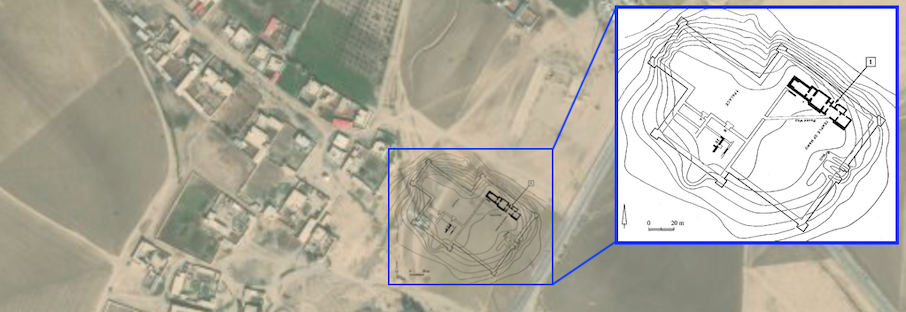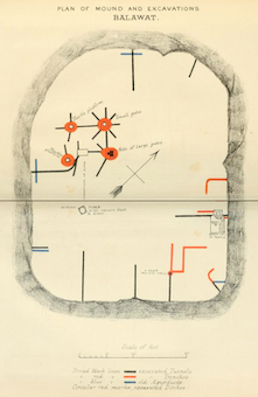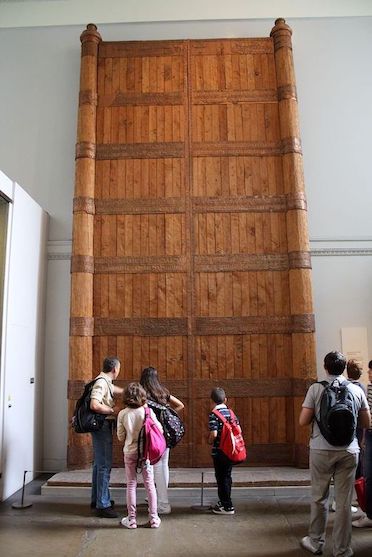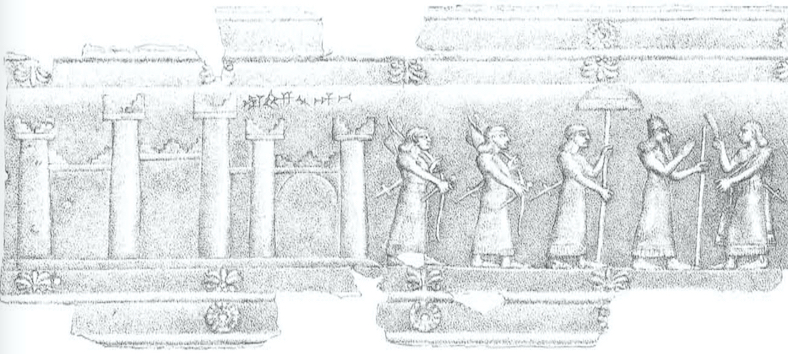You are seeing an unstyled version of this site. If this is because you are using an older web browser, we recommend that you upgrade to a modern, standards-compliant browser such as FireFox [http://www.getfirefox.com/], which is available free of charge for Windows, Mac and Linux.
Neo-Assyrian Archival Texts from Imgur-Enlil

The ancient Assyrian city of Imgur-Enlil corresponds to the archaeological site of Balawat, which lies at a distance of just under 30 km from Nineveh, with which it was connected in Assyrian times by a direct road (mentioned as a field boundary in BT 136 [/atae/imgurenlil/P522846] line 8: KASKAL URU.ni-nu-a). This road connected Nineveh via the crossing of the Upper Zab near Tell Abu Sheetha with the provincial capital of Kilizu (modern Qasr Shamamok [https://www.orient-mediterranee.com/spip.php?article1066]) and further along via the crossing of the Lower Zab at Altun Kupri with the provincial capital of Arrapha (modern Kirkuk). When departing from Nineveh, Imgur-Enlil constituted therefore the first stop along this important south-easterly route. In Neo-Assyrian times, the ancient settlement mound stood in the midst of a large lower town of ca. 52 hectares that was surrounded by fortification walls in a distinctive square layout and a length of 800 m per side. The mound rises fifteen metres above the lower town and houses a large palace complex and the city's main sanctuary, a temple dedicated to Mamu, the god of dreams. The settlement was rebuilt in this way by Ashurnasirpal II [/riao/theassyrianempire883745bc/ashurnasirpalii/index.html] (882–859 BC), possibly as a country retreat when in need of peace and quiet from the bustle of his nearby capital city of Kalhu (modern Nimrud [https://www.ucl.ac.uk/sargon/essentials/cities/kalhu/]), located ca. 15 km southwest of Balawat.

Hormuzd Rassam's Balawat excavation plan from 1882. Source: "Excavations and discoveries in Assyria [https://archive.org/details/transactions07soci/page/n71/mode/2up?view=theater]," in: Transactions of the Society of Biblical Archaeology, vol. 7, pp. 37-58, 1882. This image is in the public domain.
Balawat was first explored by Hormuzd Rassam in 1878. Excavating there on behalf of the British Museum, his work was cut short because the settlement mound is partially covered by extended cemeteries serving the modern settlement of Balawat and other nearby villages. This makes excavating at the site logistically and also ethically challenging, as Rassam and all subsequent excavators have found. However, despite the limited nature of his work, Rassam made some very important discoveries. Firstly, he uncovered a stone foundation box that contained two stone tablets with inscriptions of Ashurnasirpal II [/riao/Q004504/], which provided the site's ancient name and the identification of the corresponding building as the Mamu temple.

Replica of Shalmaneser III's temple gate from Imgur-Enlil (modern Balawat) in the British Museum. Photo Credit:Shadowgate [https://www.flickr.com/people/79586279@N00]. This image is licensed under the Creative Commons Attribution 2.0 Generic license [https://creativecommons.org/licenses/by/2.0/deed.en].
Secondly, Rassam found the remains of two monumental sets of gates from that temple and the adjoining royal palace complex. Their wooden door leaves had disintegrated in the soil long ago, and left behind were therefore only the richly decorated, embossed strips of bronze that had once served to bind the gigantic cedar planks together. One of these so-called "Balawat Gates" had been commissioned by Ashurnasirpal [/riao/Q004505/] and the other, much larger one by his son and successor Shalmaneser III [/riao/Q004610/] (858–824 BC). They are now on display in the British Museum, and especially the full-size replica of Shalmaneser's door leaves, with an impressive height of 6.8 m, gives visitors a good idea of the scale and grandeur of imperial Assyrian architecture. The intricate decorations on the bronze bands provide detailed illustrations of the kings' military campaigns, with key sites and events identified by labels. Today, the "Balawat Gates" are counted among the most important artefacts to survive from the 9th century BC, and their discovery is deemed "a landmark in the history of Assyrian art" (David Oates, Iraq 36 [1974]: 173).
Balawat was again investigated in 1956–57 by a team of the British School of Archaeology in Iraq headed by Sir Max Mallowan, as a side project to the large-scale excavations in nearby Kalhu. Further excavations were conducted at the Mamu temple and succeeded in uncovering there a third set of bronze bands from a second monumental gate commissioned by Ashurnasirpal II (whose fragmentary inscription was published by I.L. Finkel in the 2008 volume edited by John Curtis and Nigel Tallis, pp. 70–71). On display in the Archaeological Museum of Mosul, these elaborately decorated metal strips were sadly targeted by looters in April 2003 in the aftermath of the American-led invasion of Iraq, and about thirty fragments were removed, their current whereabouts unknown. Should these pieces ever turn up on the art market, the very detailed 2008 publication should enable their quick identification.
During Mallowan's 1957 field season, two small rooms were excavated to the east of the Mamu temple's inner sanctuary, and a collection of forty Neo-Assyrian clay tablets was found in "Room 8." Barbara Parker published twenty-nine of these texts, "the others being too badly preserved to give a useful text" (Iraq 25 [1963]: 86). The rest of the tablets are known only from the catalogue in Appendix 4 in the 2008 volume edited by John Curtis and Nigel Tallis (p. 92-93). The bulk of the published tablets were written during the reigns of Sennacherib [/rinap/rinap3/] (704–681 BC) and Esarhaddon [/rinap/rinap4/] (680–669 BC) and date to the years between 697 and 671 BC. These texts document the business activities of Šumma-ilu, who appears in ten texts in a central function and is identified as the "priest of the city of Imgur-Enlil" in one of them (BT 119 [/atae/imgurenlil/P522837] lines 2–3: mšúm-ma-[DINGIR] LÚ*.SANGA ša URU URU.im-gúr-dBE). With the Mamu temple being the principal shrine of Imgur-Enlil, Šumma-ilu certainly served as a priest to that deity, and his connection to the temple explains why his texts were stored in a side room of that building. Šumma-ilu's connection to the other central figures of the archive, most prominently Mamu-iqbi who appears in six texts dated between 692 and 685 BC, is not clear. The two men may have been related, or they may have had a professional connection through the temple, or perhaps a combination of both. Although Mamu-iqbi's title is not mentioned in any of the known texts his name (meaning "The god Mamu spoke") signals a close link with the deity. Whether he too served among the Mamu temple's clergy or not, he was certainly no less distinguished a member of Assyrian society than Šumma-ilu as he appears e.g. as the creditor of the provincial governor of Arzuhina (BT 124 [/atae/imgurenlil/P522840]).
The group of texts from Room 8 also contained three documents with significantly earlier dates: a field sale from 734 BC (BT 106 [/atae/imgurenlil/P522826]; the buyer is a man called Nazî); an agreement concerning the delivery of 300 sheep with their young and fleeces from 719 BC (BT 131 [/atae/imgurenlil/P522845]); and a silver debt note from 710 BC (BT 101 [/atae/imgurenlil/P522821]; creditor is a man called Ṣilli-Bel) — presumably, these texts concern the business activities of predecessors and / or family members of Šumma-ilu and Mamu-iqbi.

King Ashurnasirpal II of Assyria and his attendants depicted in front of the city of Imgur-Enlil, identified by the label URU.im-gur-dBE. Detail from a bronze band (MM Ash II R1) excavated in 1956. Drawing by Marjorie Howard, reproduced from J.E. Curtis and N. Tallis (eds.), The Balawat Gates of Ashurnasirpal II, London 2008, Fig. 74.
Already during Mallowan's 1956 excavations at Balawat, twenty more tablets had been found in debris outside the south-west wall of the Mamu temple. Of eight of these, the dates have been reported by Alan Millard in his 1994 book on the Assyrian year eponyms, and these documents range from an isolated early text from 764 BC (BT 22) to five tablets from the reign of Ashurbanipal [/rinap/rinap5/] (668–ca. 631 BC; 668 BC: BT 23, BT 33 and BT 35; 658 BC: BT 32; and the post-canonical eponym Nabû-da''inanni in BT 24) and two texts from the reign of Sîn-šarru-iskun [/rinap/rinap5/] (ca. 626–612 BC; BT 26 and BT 34: post-canonical eponym Aššur-matu-taqqin). Appendix 4 in the 2008 volume edited by John Curtis and Nigel Tallis provides a catalogue of the complete text finds of that excavation season (p. 91), but none of these tablets have been published in full. As the 1957 text finds, they are kept in the Iraq Museum.
A team of the British Museum led by John Curtis returned to Balawat in 1989 with a view of resuming large-scale excavations. However, after a promising first season succeeded in opening a small sounding in the settlement mound and in conducting a detailed surface survey, further work became impossible when the First Gulf War started in 1990.
Click here [/atae/imgurenlil/pager] to browse the Imgur-Enlil corpus.
The aim of the Imgur-Enlil sub-project of ATAE is to make the published Neo-Assyrian archival texts from Balwat available online for free in a fully searchable and richly annotated (lemmatized) format, as well as to widely disseminate, facilitate, and promote the active use of these important cuneiform sources in academia and beyond. ATAE/Imgur-Enlil presently includes Neo-Assyrian sources edited and discussed in the following publication:
- J.E. Curtis, D. Collon and A. Green, "British Museum Excavations at Nimrud and Balawat in 1989," [https://www.jstor.org/stable/4200365] Iraq 55 (1993): 1-37;
- J.E. Curtis and N. Tallis (eds.), The Balawat Gates of Ashurnasirpal II, London 2008;
- K. Deller, "Marginalien zu den Rechtsurkunden aus Balawat," [https://www.jstor.org/stable/43079618] Orientalia NS 34 (1965): 169;
- A. Millard, The Eponyms of the Assyrian Empire, 910-612 BC [/saao/saas2/] (State Archives of Assyria Studies 2), Helsinki 1994 [see index s.v. Balawat on p. 136];
- D. Oates, "Balawat (Imgur Enlil): The Site and Its Buildings," [https://www.jstor.org/stable/4199984] Iraq 36 (1974): 173–178;
- Barbara Parker, "Tablets from the Temple of Mamu at Balawat," [https://www.jstor.org/stable/4199734] Iraq 25 (1963): 86–103.
- J.N. Postgate, Fifty Neo-Assyrian Legal Documents, Warminster 1976, no. 20 (= BT 124 [/atae/imgurenlil/P522840/]) and no. 34 (= BT 104 [/atae/imgurenlil/P522824/]) [passages of many other Balawat texts are discussed throughout this book, see index on p. 219];
- J.N. Postgate, Taxation and conscription in the Assyrian Empire, Rome 1974, pp. 358–360 (= BT 116 [/atae/imgurenlil/P522834/]); and
- A. Schachner, Bilder eines Weltreichs: kunst- und kulturgeschichtliche Untersuchungen zu den Verzierungen eines Tores aus Balawat (Imgur-Enlil) aus der Zeit von Salmanassar III., König von Assyrien, Turnhout 2007.
ATAE is a key component of the Archival Texts of the Middle East in Antiquity (ATMEA) sub-project of the LMU-Munich-based Munich Open-access Cuneiform Corpus Initiative [https://www.en.ag.geschichte.uni-muenchen.de/research/mocci/index.html] (MOCCI; directed by Karen Radner and Jamie Novotny). Funding for the ATAE corpus project has been provided by LMU Munich and the Alexander von Humboldt Foundation (through the establishment of the Alexander von Humboldt Chair for Ancient History of the Near and Middle East).
For further details, see the "About the project" [/atae/abouttheproject/index.html] page.

Home Page banner credit
Satellite image of the ruins of Imgur-Enlil overlaid with a general plan of the citadel, showing the location of the small archive belonging to Šumma-ilu and Mamu-iqbi discovered in Room 8 of the Mamu temple. Image prepared by Jamie Novotny from Pedersén, Archives and Libraries in the Ancient Near East 1500-300 B.C. p. 167 plan 78.
Karen Radner
Karen Radner, 'Neo-Assyrian Archival Texts from Imgur-Enlil', Neo-Assyrian Archival Texts from Imgur-Enlil, The ATAE/Imgur-Enlil Project, a sub-project of MOCCI, 2023 [http://oracc.org/imgurenlil/]